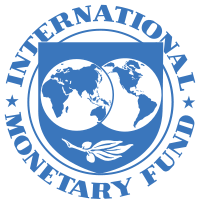The  International Monetary Fund (IMF) is an international organization headquartered in Washington, D.C., in the United States, of 189 countries working to foster global monetary cooperation, secure financial stability, facilitate international trade, promote high employment and sustainable economic growth, and reduce poverty around the world. Formed in 1944 at the Bretton Woods Conference, it came into formal existence in 1945 with 29 member countries and the goal of reconstructing the international payment system. Countries contribute funds to a pool through a quota system from which countries with payment imbalances can borrow. As of 2010, the fund had SDR 476.8 billion, about US$755.7 billion at then-current exchange rates. Through this fund, the IMF works to improve the economies of its member countries.
International Monetary Fund (IMF) is an international organization headquartered in Washington, D.C., in the United States, of 189 countries working to foster global monetary cooperation, secure financial stability, facilitate international trade, promote high employment and sustainable economic growth, and reduce poverty around the world. Formed in 1944 at the Bretton Woods Conference, it came into formal existence in 1945 with 29 member countries and the goal of reconstructing the international payment system. Countries contribute funds to a pool through a quota system from which countries with payment imbalances can borrow. As of 2010, the fund had SDR 476.8 billion, about US$755.7 billion at then-current exchange rates. Through this fund, the IMF works to improve the economies of its member countries.
Special Drawing Rights (SDRs)
A Special Drawing Right (SDR) is basically an international monetary reserve asset. SDRs were created in 1969. The value of an SDR consists of the value of four of the IMF’s biggest members’ currencies—the US dollar, the British pound, the Japanese yen, and the euro—but the currencies do not hold equal weight. SDRs are quoted in terms of US dollars. The following chart shows the current valuation in percentages of the four currencies.
|
Currency
|
Weighting
|
| US dollar |
41.73 percent |
| Euro |
30.93 percent |
| Chinese Yuan |
10.92 percent |
| Japanese yen |
8.33 percent |
| Pound Sterling |
8.09 percent |
Headquarters of International Monetary Fund
The Headquarters of IMF is situated at Washington, D.C.
Functions of International Monetary Fund
- To promote international monetary cooperation through a permanent institution which provides the machinery for consultation and collaboration on international monetary problems.
- To facilitate the expansion and balanced growth of international trade, and to contribute thereby to the promotion and maintenance of high levels of employment and real income and to the development of the productive resources of all members as primary objectives of economic policy.
- To promote exchange stability, to maintain orderly exchange arrangements among members, and to avoid competitive exchange depreciation.
- To assist in the establishment of a multilateral system of payments in respect of current transactions between members and in the elimination of foreign exchange restrictions which hamper the growth of world trade.
- To give confidence to members by making the general resources of the Fund temporarily available to them under adequate safeguards, thus providing them with opportunity to correct maladjustments in their balance of payments without resorting to measures destructive of national or international prosperity.
- To ensure the stability of the international monetary system.
- To work with governments around the world to modernize their economic policies and institutions, and train their people
Key IMF activities
The IMF supports its membership by providing
- Policy advice to governments and central banks based on analysis of economic trends and cross-country experiences;
- Research, statistics, forecasts, and analysis based on tracking of global, regional, and individual economies and markets;
- Loans to help countries overcome economic difficulties;
- Concessional loans to help fight poverty in developing countries
- Technical assistance and training to help countries improve the management of their economies.
IMF Board of Governors
The Board of Governors, the highest decision-making body of the IMF, consists of one governor and one alternate governor for each member country. The governor is appointed by the member country and is usually the minister of finance or the governor of the central bank. All powers of the IMF are vested in the Board of Governors. The Board of Governors normally meets once a year
Managing Director of International Monetary Fund
Kristalina Georgieva was selected Managing Director of the IMF on September 25, 2019. She assumed her position on October 1, 2019
Download as PDF
Read next article: World Bank ››
Read previous article: « Facts about Indian Rupee
« Back to banking material page